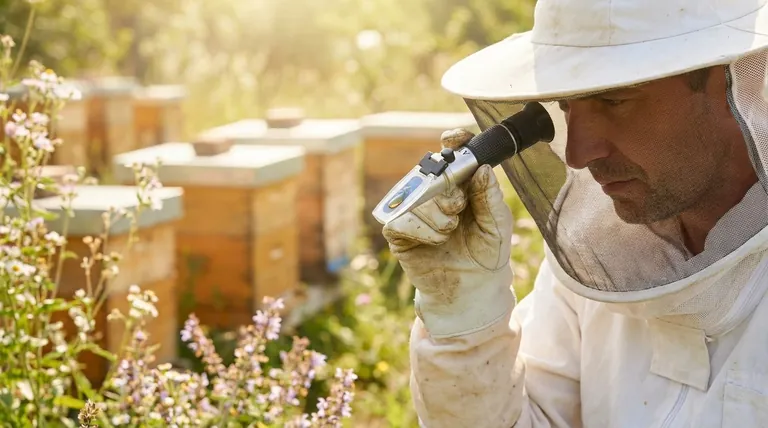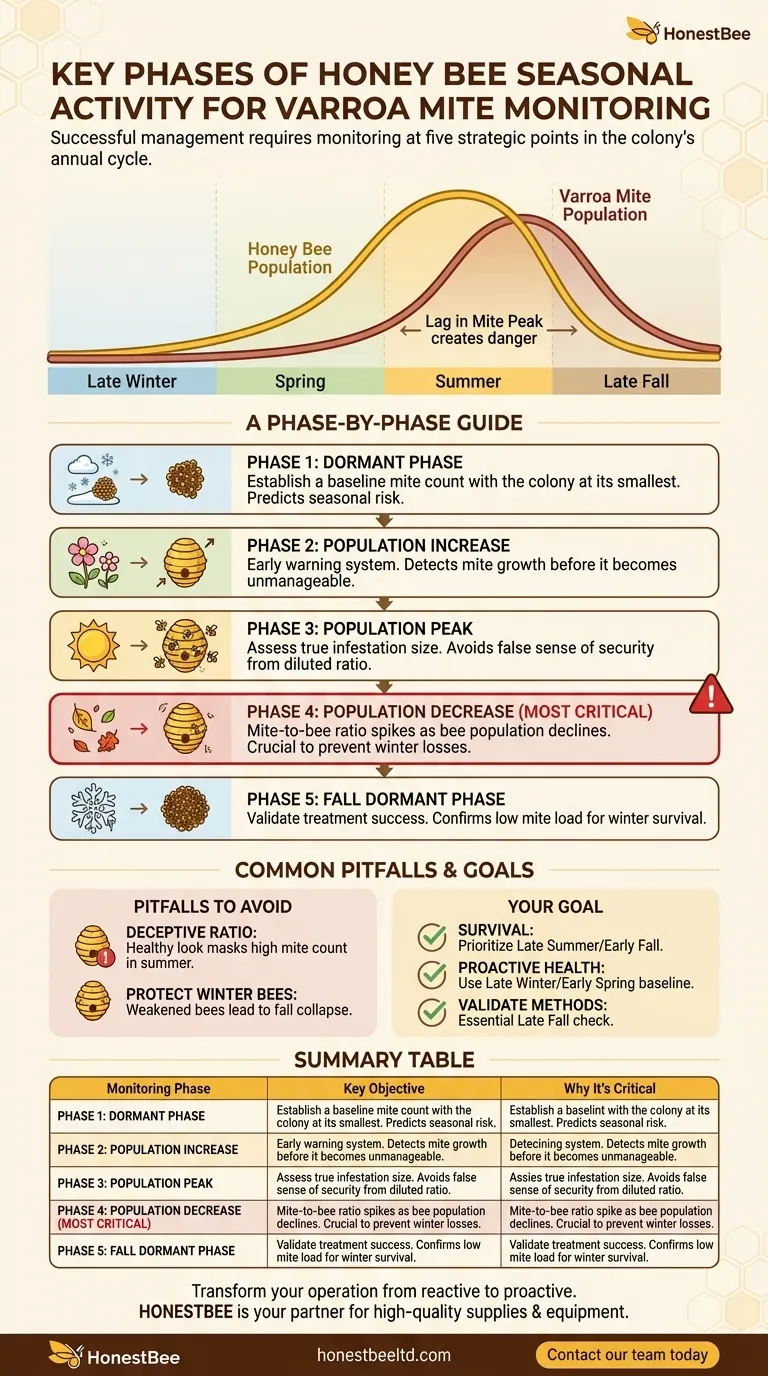At its core, successful Varroa mite management requires monitoring during five key phases of the honey bee colony's seasonal cycle. These are the late winter dormant phase, the spring population increase, the summer population peak, the late summer population decrease, and the fall dormant phase. Consistent monitoring at these junctures allows you to track mite levels as they correlate with the bee population and intervene before the infestation becomes catastrophic.
The central principle of effective mite control is not simply to treat, but to monitor at strategic points in the honey bee lifecycle. The most dangerous phase is often when the bee population begins to decline in late summer, as this is when the mite-to-bee ratio can spike to lethal levels.

The Intertwined Cycles of Bees and Mites
To understand why these specific monitoring times are critical, you must first understand the relationship between the host (the bees) and the parasite (the Varroa mite). The two populations are intrinsically linked, but they do not rise and fall in perfect sync.
The Host Population Cycle
A healthy honey bee colony follows a predictable annual population curve. It starts small in the spring, grows exponentially as the queen lays eggs, peaks in mid-summer during the main nectar flow, and then declines in the fall to a smaller, more compact winter cluster.
The Parasite Population Cycle
The Varroa mite population follows the bee population's lead. Mites reproduce within capped brood cells, so as the colony's brood rearing increases, the mite population explodes. However, the mite population peaks slightly after the bee population, creating a critical and dangerous lag.
A Phase-by-Phase Guide to Mite Monitoring
Monitoring should occur a minimum of four times per year, ideally aligned with these five biological phases. This allows you to gather crucial data to make informed treatment decisions.
Phase 1: Late Winter / Early Spring (Dormant Phase)
Before the queen begins laying heavily, the colony is at its smallest. Monitoring now provides a clean baseline mite count for the season. This tells you the colony's starting parasite load, which is a key predictor of future problems.
Phase 2: Spring (Population Increase)
As the colony expands and brood rearing accelerates, so does mite reproduction. Monitoring during this buildup phase is an early warning system. High counts at this stage indicate the need for early intervention before the population becomes unmanageable.
Phase 3: Summer (Population Peak)
When the bee population is at its maximum, the sheer number of bees can dilute the mite-to-bee ratio. This can give a false sense of security. Monitoring now is essential to understand the true size of the mite infestation before the bee population begins its natural decline.
Phase 4: Late Summer / Early Fall (Population Decrease)
This is the most critical monitoring period. As the queen reduces her laying rate and the summer bees die off, the bee population shrinks. However, the mite population is still near its peak. This causes the mite-to-bee ratio to skyrocket, placing immense pressure on the remaining bees, especially the crucial generation of "winter bees" that must survive until spring.
Phase 5: Late Fall (Fall Dormant Phase)
After fall treatments have been applied, a final check is necessary. This monitoring phase validates the effectiveness of your treatment and confirms that the winter cluster has a low mite load, giving it the best possible chance of survival.
Common Pitfalls to Avoid
Trusting visual inspections or waiting for overt symptoms is a recipe for failure. The key is to act on data from monitoring before the colony is visibly weak.
The Danger of a Deceptive Ratio
In mid-summer, a colony may have tens of thousands of mites but still appear healthy because it also has over 60,000 bees. The real damage occurs when those tens of thousands of mites are left with only 20,000 bees in the fall.
Protecting the Winter Bees
Winter bees are physiologically different; they are built for longevity. If they are weakened by mite-vectored viruses during their development in late summer, they will not live long enough to get the colony through winter, leading to a common issue known as fall collapse.
Making the Right Choice for Your Goal
Your monitoring strategy should align with your primary objective as a beekeeper.
- If your primary focus is colony survival: Prioritize the late summer/early fall monitoring period, as this is the single most important time to prevent winter losses.
- If your primary focus is proactive, long-term health: Use the late winter/early spring test to establish a baseline that informs your entire season's management plan.
- If your primary focus is validating your methods: The late fall check is essential for confirming whether your treatment regimen was successful and making adjustments for next year.
Ultimately, systematic monitoring transforms you from a reactive keeper into a proactive manager of your colonies' health.
Summary Table:
| Monitoring Phase | Key Objective | Why It's Critical |
|---|---|---|
| Late Winter / Early Spring | Establish a baseline mite count | Predicts seasonal risk with the colony at its smallest size. |
| Spring | Early warning system | Detects mite population growth before it becomes unmanageable. |
| Summer | Assess true infestation size | Avoids a false sense of security from a diluted mite-to-bee ratio. |
| Late Summer / Early Fall | Prevent winter losses | Most critical phase - mite-to-bee ratio spikes as bee population declines. |
| Late Fall | Validate treatment success | Confirms a low mite load for the winter cluster's survival. |
Transform your beekeeping operation from reactive to proactive.
Effective Varroa mite management is the cornerstone of a thriving apiary. For commercial beekeepers and equipment distributors, consistent monitoring and the right supplies are non-negotiable for protecting your investment and ensuring colony health.
HONESTBEE is your dedicated partner in this mission. We supply the high-quality, reliable beekeeping supplies and equipment you need to implement a successful monitoring and treatment strategy.
Contact our team today to discuss your specific needs. Let us help you equip your operation for success and build a healthier, more productive future for your bees.
Visual Guide

Related Products
- Precision Honey Refractometer Instrument for Quality Assessment
- Efficient Hive Clearing: HONESTBEE 8-Way Plastic Bee Escape
- Premium Traditional Copper Bee Smoker with Bellows
- High Performance Cordless Electric Bee Shaker for Beekeeping
- Circular Labyrinth Bee Escape for Efficient Hive Management
People Also Ask
- Why is a honey refractometer essential for honey harvesting? Protect Your Harvest from Spoilage
- What is a honey refractometer? The Essential Tool for Perfect Honey Quality
- How does a honey refractometer work? Ensure Honey Quality & Harvest Readiness
- Why is a honey refractometer considered essential for commercial beekeepers? Ensure Honey Quality and Profitability
- What are the key points for proper usage of a honey refractometer? Ensure Accurate Moisture Readings Every Time



















